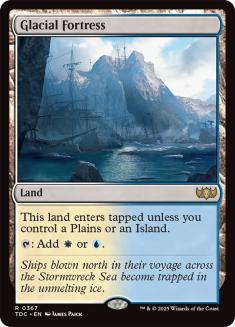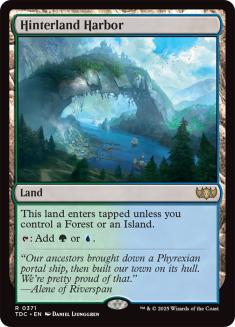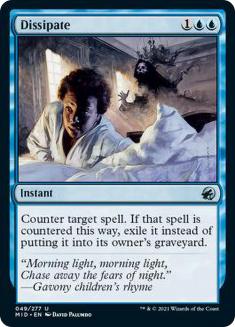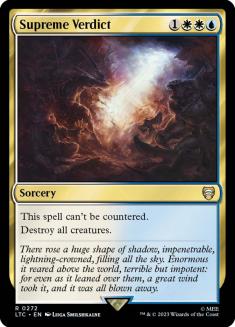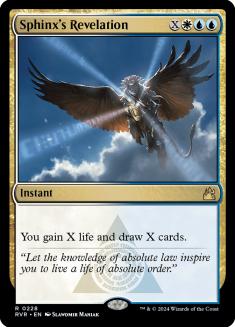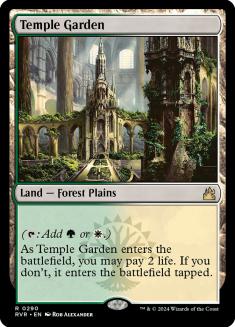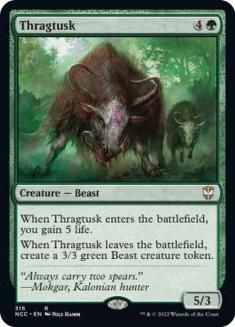Dramatis Personae
Reid Duke: First proposed the shell of Bant Control.
Sam Black (with Andrew Cuneo): Did most of the legwork in testing and tuning the deck.
Andrew Cuneo: Captain of “Team Bant Control.” Everyone’s decklist came within a few cards of Andrew’s version.
Huey Jensen: Contributor to Bant and an expert on Block Constructed U/W Control. Huey accurately predicted and helped us brainstorm solutions to the problems we would run into with the deck.
Owen Turtenwald; Shahar Shenhar; Patrick Chapin: Played Bant Control to Top 32 finishes at GP Charleston. Before the event, most of my interactions with these three were indirect through Andrew.
Act I: The Development of Bant Control
Our Grand Prix Charleston deck wasn’t an individual effort, nor did we all settle on the same decklist. Here’s what I played:
Creatures (5)
Planeswalkers (1)
Lands (26)
Spells (28)

Here’s how I deviated from the “team deck.” I was the only one to play the singleton Pithing Needle, Ground Seal, and Tamiyo, the Moon Sage in the maindeck and Sigarda, Host of Herons in the sideboard. I was the only one not to play the maximum number (nine) of shocklands. I was the only one not to play three copies of Augur of Bolas. Andrew and I played Amass the Components while everyone else played Jace, Architect of Thought.
I can’t say for sure whether my deviations were good or bad; the consensus among everyone else (at least before the tournament) was that they were bad. However, when I play control decks, I develop very specific ways that I like to play and sideboard in each matchup, so this was the deck that made sense for me.
The goal of Bant Control is to survive and make land drops. The game eventually reaches a point where you can play Sphinx’s Revelation for five to ten every other turn, drawing into a second Revelation and an Elixir of Immortality to reshuffle. The combination of hard counters, board sweepers, and life gain ensures that you can never lose once the game gets to this point. Winning comes at your convenience from attacking with Thragtusk or from a single copy of Nephalia Drownyard.
Bant is at its strongest against non-blue midrange decks like Tokens or Jund (before Slaughter Games comes in). I respect these decks in the same way I respect the lions at the zoo: fierce and majestic creatures, but they do look sort of silly roaring at me through six inches of bulletproof glass. The fact is that, unless things go very wrong, midrange decks basically cannot touch you. They’re too slow with not enough reach to win before Sphinx’s Revelation comes online, and they have nothing to disrupt Bant’s late-game engine once it gets to that point. Traditional methods of grinding out control decks with resilient threats and two-for-one trades don’t work against Bant.
The aggro matchups are straightforward; Thragtusk and Supreme Verdict are your most important tools to buy time until the powerful late-game engine kicks in. The weakness of the deck is its lack of relevant early plays, so looking at an opening hand without a Farseek or an Azorius Charm is never a good feeling. Augur of Bolas, which my teammates adopted, provides one more welcome roadblock in these matchups. I went the entire Grand Prix without facing Mono-Red Aggro, so I was able to avoid the matchups which may have punished me for the choices I’d made in deckbuilding.
The blue mirrors are not straightforward at all and depend a lot on the exact builds of each deck. It would take a full article to adequately explain any of these matchups, but take my word that I had some reasoning for the oddball one-ofs in my list. Pithing Needle provides a preemptive answer to Runechanter’s Pike so that a flash creature cannot kill you from 24 life in the end game. Ground Seal is a response to Snapcaster Mage giving your opponent four extra hard counters in their deck. Sigarda, Host of Herons, who is really something special with Cavern of Souls, offers an alternative win condition for the games where Rest in Peace shuts off the Elixir of Immortality game plan.
Act II: Grand Prix Charleston Day 1
Tournament hall, overpriced concessions and vending machines loom in the background.
Enter Reid, Owen, Cuneo, Duke of Milan, Handmaid I, Handmaid II.
Owen:Good luck in round 4.
Reid:Good luck in round 4.
Round 4
Enter Joe Bernal with U/W Flash.
After three byes, I started the tournament by losing game 1 to a good player with U/W Flash. This is a matchup where game 1 is squarely unfavorable but the post-board games are very winnable. Unfortunately, losing game 1 is an especially big problem with Bant because of how long it takes to win a game. Losing a long game 1, I wasn’t optimistic about escaping the match with a win.
However, in game 2 I had a great draw with Rest in Peace to shut down Runechanter’s Pike and Cavern of Souls + Sigarda to shut down everything else. Joe told me he’d lost sleep before the tournament worrying about that exact sequence of plays; what is it they say about knowing your enemy?
Game 3 Joe mulliganed to five and made a good fight of it, countering the first four or five spells I played. In the end, though, this is not a matchup where being down two cards can be easily overcome, Joe ran out of steam a little before I did, and I took the match.
4-0
Over the course of the tournament, I went 2-0 against U/W Flash and 2-0 against U/W/R Midrange. I’d say U/W is a 50/50 matchup but is very challenging to play. U/W/R is a good matchup since they don’t often have Runechanter’s Pike and have to tap out more on their main phase.
Round 5
Enter Stephan Sloan with a mysterious deck.
Stephan was playing what I thought was his RUG homebrew featuring Thragtusk, Huntmaster of the Fells, Syncopate, and Bonfire of the Damned. After a few Supreme Verdicts, I took the game exactly where I wanted it to be, chaining Revelations with a hand full of Dissipates. One turn, Stephan played Deadeye Navigator, at which point I paused. He could repeatedly Blink a Thragtusk or Huntmaster for a bunch of life, but I wasn’t going to kill him with damage anyway, so I figured it was nothing a few Supreme Verdicts couldn’t take care of and let it resolve.
Next, Stephan used Cavern of Souls to play Zealous Conscripts, untapped his Gilded Lotus, and soulbonded to his Navigator. Reading this, you might be able to tell where this is going, but at the time, I still couldn’t see the writing on the wall. Stephan repeatedly Blinked his Conscripts to untap his Lotus, generating infinite mana. Next he Blinked his Conscripts twenty times to steal every permanent I controlled. Then he played Bonfire of the Damned for 9999.
This was a low point in the tournament for me. My inexperience in the format had directly cost me a game (all I had to do to win was counter Deadeye Navigator). The worst part was that I had lost a game it looked like I was going to win. Normally, I can at least salvage a loss by conceding early and saving time for the next two games, but in this case we started game 2 with under twenty minutes on the clock.
Like the previous round, Stephan mulliganed to five in one game and was quickly beaten to death by Sigarda. Game 3 was an exciting one where I played Jace, Memory Adept as soon as it was safe to do so. Anticipating trouble, I used my first two activations to draw an extra card and found a Supreme Verdict in the nick of time. By the time Stephan killed Jace, I had a Drownyard active, and he started turn 5 of extra turns with zero cards in his library.
5-0
Round 6
Enter Josh Utter-Leyton accompanied by his villainous theme music with Craterhoof Reanimator.
Josh Utter-Leyton didn’t turn out to be the villain of this story, but he was my only loss in the Swiss. It was not so much his Reanimator strategy, which I was well prepared for, but more his hard casting of Craterhoof Behemoth that got me in both games. At least I got to finish one round with time on the clock!
5-1
I beat more traditional Reanimator decks 2-0.
Act III: Grand Prix Charleston Day 2
Round 12
Enter Alex Majlaton with U/W Flash.
Round 12 I had a non-camera feature match against a friend, Alex Majlaton. It ended up being another low point in the tournament, but for a different reason. Deep in game 1, Alex had a Syncopate in his hand, which had been revealed by Augur of Bolas. One turn, he tapped all but three lands to make a Moorland Haunt token during my end step. I had nine lands in play, tapped all but two of them, and said, “Sphinx’s Revelation for five.” Alex said okay, I marked +5 on my life pad, and drew five cards. I untapped, took my turn, and passed back.
On Alex’s turn, I began to plan out my next move, counted my mana, and realized that I had tapped seven lands and announced a Sphinx’s Revelation for five! I called a judge and explained the situation, that I had had enough lands to cast a Revelation for five but was not able to make that play for strategic reasons. The judge ruled that it was too late to back up the game and that I would keep my extra card. I asked if Alex and I could make some agreement between ourselves (for instance, that I skip my next draw step), but the judge told us not to do anything outside the rules. We played it out, and I won the game.
Given the judge’s ruling, I suppose I only had two more options. I could have offered to concede the game, which felt like an extreme measure. Also, good sport he is, it’s likely that Alex wouldn’t have accepted anyway. The other would have been to draw the game, which may have been an option in an untimed Top 8, but under the circumstances and the clock pressures, it would have probably led to the winner of game 2 winning the entire match.
I ended up winning this match 2-0, and it’s impossible to say if the extra card did or didn’t influence the outcome of game 1. I was ahead in the game (I was resolving a Revelation, after all), but it had certainly not been determined yet. It’s a shame when a high-stakes match can’t be played in a clean, fair way.
11-1
I was frankly shocked that I made such an error, especially after playing eight rounds with the deck already. I can promise that it never happened before and will never happen again. The only lesson I can take is that cameras and high pressure can do strange things to people.
Quarterfinals
Enter Peter Kelly with W/G Humans.
I felt this was a lucky pairing for me, as I had beaten Peter 2-0 when we played in the Swiss. In his player profile, he listed Supreme Verdict decks as his worst matchup. Relevantly, I got to play first since I was in first place after the Swiss.
That said, Peter had a terrifying deck. It was nearly all creatures, most of which cost one or two mana. He had four Thalia, Guardian of Thraben, and he could dish out damage fast. I was definitely looking for Supreme Verdict in my opening hand.
Be careful what you wish for, I suppose; I had two Verdicts but not the mana to cast them. I’d need to draw two lands quickly (preferably in my first three draw steps) or, if he played Thalia, three lands in my first four draw steps. I thought for as long as the rules allowed and decided to mulligan.
My second hand was something close to what I’ve listed above. It was a two lander with no Farseek, Think Twice, or Supreme Verdict. Though it was worse than my first hand, the decision was equally close since I was faced with the prospect of going down to five cards. I did. Thankfully, Peter did also, just to keep things fair.
The game quickly came to a race where I had no removal but played three Thragtusks in a row while Peter put a Rancor on a Judge’s Familiar. When I untapped for my final turn, Peter had to chump block with everything besides the Familiar just to survive one more turn. I was at one life facing down the three-power flier with Sphinx’s Revelation in my hand and five lands in play. Had I drawn a land that turn, I would have been an odds-on favorite to win the game, but I didn’t so Peter was able to win the race.
Game 2 I had a good draw with a Supreme Verdict, and Peter conceded to a large Revelation on a stable board.
Game 3 was as close as game 1, and I ended my tournament with what, with the benefit of hindsight, I’ve decided was a mistake. Peter had a Knight token with Rancor, three cards in his hand, and had been stuck on three lands for a few turns. I had two life, six lands (after playing one), Elixir of Immortality, and my hand contained Thragtusk, Centaur Healer, Supreme Verdict, and more lands. I typically like to wait as long as possible to sacrifice Elixir of Immortality since that way its effect will be more powerful and I’ll have a lower chance of drawing it again right away. I played my Thragtusk and brought myself up to seven, thinking to use my mana effectively and stabilize the board as quickly as possible. I knew Peter’s deck and knew that no single card could kill me from that situation.
What happened was that Peter finally drew his fourth land, played a Silverblade Paladin to soulbond, played a second Rancor on his Knight, and attacked for twelve trample damage.
Exeunt.
If I could have predicted that Peter had those two cards, I should have played Centaur Healer and left enough mana to crack my Elixir. That would have allowed me to survive his attack at one life, untap and play Supreme Verdict, and then take it from there.
Tune in for Act IV, which will be staged at Grand Prix San Antonio this weekend. Or pick up the deck yourself and try out for a part!

